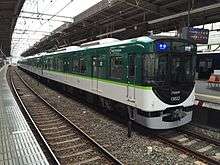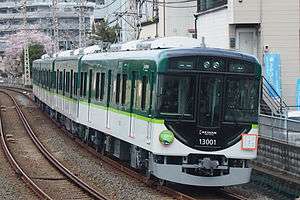Keihan 13000 series
| Keihan 13000 series | |
|---|---|
|
Set 13001 on the Uji Line in April 2012 | |
| In service | 14 April 2012 |
| Manufacturer | Kawasaki Heavy Industries |
| Built at | Kobe |
| Family name | City commuter |
| Replaced | Keihan 2600 series |
| Constructed | 2013– |
| Number built | 38 vehicles (8 sets) |
| Number in service | 38 vehicles (8 sets) |
| Formation | 4/7 cars per trainset |
| Fleet numbers | 13001– |
| Capacity | 540 |
| Operator(s) | Keihan Electric Railway |
| Line(s) served | Keihan Uji Line, Keihan Katano Line |
| Specifications | |
| Car body construction | Aluminium alloy |
| Car length |
18,900 mm (62 ft 0 in) (end cars) 18,700 mm (61 ft 4 in) (intermediate cars) |
| Width | 2,792 mm (9 ft 1.9 in) |
| Doors | 3 pairs per side |
| Maximum speed | 110 km/h (70 mph) |
| Traction system | variable-frequency |
| Acceleration | 2.8 km/h/s |
| Deceleration | 4.0 km/h/s (service), 4.3 km/h/s (emergency) |
| Electric system(s) | 1,500 V DC |
| Current collection method | Overhead wire |
| Bogies | KW-77D (motored), FS577 (trailer) |
| Safety system(s) | Keihan ATS |
| Track gauge | 1,435 mm (4 ft 8 1⁄2 in) |
The Keihan 13000 series (京阪13000系 Keihan 13000-kei) is an electric multiple unit (EMU) commuter train type operated by the private railway operator Keihan Electric Railway on the Keihan Uji Line and other lines in Kyoto, Japan, since April 2012. The initial order consisted of five 4-car sets, intended to replace 20 life-expired 2600 series vehicles,[1][2] and as of 1 April 2015, the fleet consists of six four-car sets and two seven-car sets.
Design
The overall design concept draws on the design of the 3000 series EMU trains introduced from 2008.[1]
The new trains include energy-saving and environmentally friendly features. The 13000 series trains will use 35% less power than the 2600 series they are intended to replace, and produce less environmental noise in service.[1] The cars feature aluminium alloy bodies with a semi-double skin construction, and incorporate increased crash resistance.[1]
The end cars are each equipped with one PT-4805-A scissors-type pantograph recycled from withdrawn rolling stock.[3]
Interior
Internally, LCD passenger information screens are provided above doorways.[1]
Longitudinal bench seating use contoured "bucket seats" with a width of 470 mm (19 in) per passenger.[1]
Luggage racks are lowered by 20 mm to a height of 1,750 mm for accessibility, with the racks above priority seating lowered 50 mm to a height of 1,720 mm.[1]
The interior flooring design is intended to evoke an image of Kyoto's traditional stone-paved streets.[4]
The 2nd-batch sets, 13006 onward, use LED lighting.[5]
- Interior of a 13020 series set, June 2014
- 7-person bench seat
- Sliding doors and LCD passenger information screen
Formations
As of 1 April 2015, the fleet consists of six four-car sets (13001 to 13006) and two seven-car sets (13021 and 13022), formed as follows, with the Mc1/Mc3 cars at the Kyoto/Uji end.[3][6]
4-car (odd-numbered) sets
| Designation | Mc1 | T0 | T1 | Mc4 |
|---|---|---|---|---|
| Numbering | 13000 | 13500 | 13650 | 13050 |
| Weight (t) | 36.0 | 28.5 | 26.0 | 36.5 |
| Capacity (total/seated) |
128/43 | 137/49 | 137/49 | 128/43 |
4-car (even-numbered) sets
| Designation | Mc3 | T0 | T1 | Mc2 |
|---|---|---|---|---|
| Numbering | 13000 | 13500 | 13650 | 13050 |
| Weight (t) | 36.5 | 28.5 | 26.0 | 36.0 |
| Capacity (total/seated) |
128/43 | 137/49 | 137/49 | 128/43 |
- "Mc" cars are motored driving cars (with driving cabs).
- "T" cars are unpowered trailer cars.
- The Mc cars each have one PT-4805-A scissors-type pantograph.[3]
- The Kyoto/Uji end Mc3 cars of even-numbered sets are fitted with gangway connections, enabling coupling to the Nakanoshima end Mc4 cars of odd-numbered sets.[3][7]
7-car sets

| Designation | Mc1 | T0 | T2 | M1 | T3 | T4 | Mc2 |
|---|---|---|---|---|---|---|---|
| Numbering | 13020 | 13520 | 13720 | 13170 | 13570 | 13770 | 13070 |
The three motored cars (Mc1, M1, and Mc2 cars) each have one single-arm pantograph.[6] The "T0" car is designated as a "mildly air conditioned" car.[6]
History
The first set, 13001, was delivered from the Kawasaki Heavy Industries factory in Kobe to Keihan's Neyagawa Depot in March 2012.[8] It entered service on 14 April 2012.[3] The second set, 13002, entered revenue service on 30 May 2012.[7]
From 9 June 2012, 13000 series sets were also introduced on the Keihan Katano Line.[9]
The first second-batch set, 13006, entered service on 7 April 2014, followed by two 7-car sets, 13021 and 13022, which entered service in May 2014.[5][6]
Fleet history
The build history for the fleet is as shown below.[6]
| Set No. | Manufacturer | Date delivered | Remarks |
|---|---|---|---|
| 13001 | Kawasaki Heavy Industries | 26 March 2012 | First batch |
| 13002 | Kawasaki Heavy Industries | 25 May 2012 | |
| 13003 | Kawasaki Heavy Industries | 8 June 2012 | |
| 13004 | Kawasaki Heavy Industries | 26 June 2012 | |
| 13005 | Kawasaki Heavy Industries | 10 July 2012 | |
| 13006 | Kawasaki Heavy Industries | 19 March 2014 | Second batch |
| 13021 | Kawasaki Heavy Industries | 23 April 2014 | |
| 13022 | Kawasaki Heavy Industries | 24 July 2014 |
References
- 1 2 3 4 5 6 7 新型車両13000系20両を新造します。 [20 New 13000 Series Cars to be Built] (PDF). News Release (in Japanese). Japan: Keihan Electric Railway. 12 December 2011. Retrieved 12 December 2011.
- ↑ 宇治・伏見観光キャンペーン [Uji & Fushimi Tourist Promotion] (PDF). News Release (in Japanese). Japan: Keihan Electric Railway. 23 March 2012. Retrieved 27 March 2012.
- 1 2 3 4 5 京阪電気鉄道13000系 [Keihan Electric Railway 13000 series]. Japan Railfan Magazine (in Japanese). Vol. 52 no. 614. Japan: Kōyūsha Co., Ltd. June 2012. pp. 78–82.
- ↑ Kameda, Sanae (12 December 2011). 京阪電鉄:来春から「13000系」20両順次導入 [Keihan Electric Railway to introduce 20 13000 series cars from next spring]. Mainichi jp (in Japanese). Japan: The Mainichi Newspapers. Retrieved 13 December 2011.
- 1 2 京阪電気鉄道13000系に2次車が登場 [Keihan 13000 series 2nd-batch set appears]. Japan Railfan Magazine (in Japanese). Vol. 54 no. 639. Japan: Koyusha Co., Ltd. July 2014. p. 99.
- 1 2 3 4 5 私鉄車両編成表 2015 [Private Railway Rolling Stock Formations - 2015] (in Japanese). Japan: Kotsu Shimbunsha. 23 July 2015. p. 135. ISBN 978-4-330-58415-7.
- 1 2 京阪13000系第2編成が営業運転を開始 [Second Keihan 13000 series set enters service]. Japan Railfan Magazine Online (in Japanese). Japan: Koyusha Co., Ltd. 1 June 2012. Retrieved 1 June 2012.
- ↑ 京阪13000系第1編成の搬入が終了 [First Keihan 13000 series set delivered]. Japan Railfan Magazine Online (in Japanese). Japan: Koyusha Co., Ltd. 14 March 2012. Retrieved 16 March 2012.
- ↑ 京阪13000系,交野線で営業運転開始 [Keihan 13000 series enter service on Katano Line]. Japan Railfan Magazine Online (in Japanese). Japan: Koyusha Co., Ltd. 10 June 2012. Retrieved 10 June 2012.
External links
| Wikimedia Commons has media related to Keihan 13000 series. |
- Official website (Japanese)
